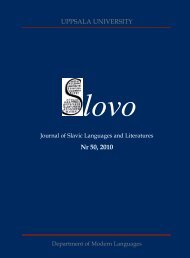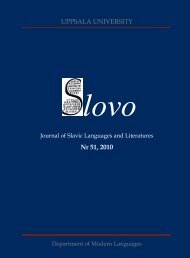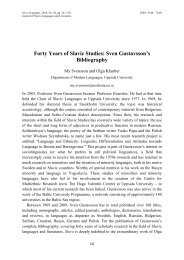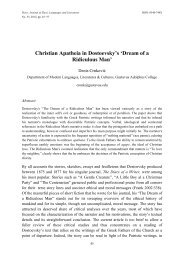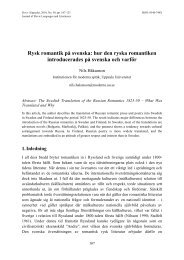Full text PDF - Index of - Uppsala universitet
Full text PDF - Index of - Uppsala universitet
Full text PDF - Index of - Uppsala universitet
Create successful ePaper yourself
Turn your PDF publications into a flip-book with our unique Google optimized e-Paper software.
Atle Grønn<br />
‘Byvalo’ and ‘used to’ as verbal quantifiers<br />
(18) He was married and had a little boy, but was separated from his wife because<br />
she had been unfaithful to him, and now he hated her and used to send her<br />
forty roubles a month for the maintenance <strong>of</strong> their son.<br />
The reader may have noticed that quite frequently in the habitual constructions above,<br />
Russian does not use a verbal quantifier, but simply marks the verb with imperfective<br />
aspect. This point will be further discussed in Section 5, but first, in the next section, I<br />
shall review the data that motivated this study.<br />
4. Corpus data: byvalo<br />
Unlike temporal auxiliaries (will, has) or periphrastic constructions (used to) in<br />
English, which subcategorize for nonfinite verb forms, the Russian byvalo combines<br />
with finite verbs. The same also holds, <strong>of</strong> course, for byvaet, but the most interesting<br />
data are those in which present tense morphology is used under the past tense<br />
quantifier byvalo.<br />
I hasten to mention that we <strong>of</strong>ten find past tense morphology in the embedded verb<br />
under byvalo:<br />
(19) Помните, вы, бывало, так говорили? (Lev Tolstoj, “Anna Karenina”)<br />
(20) Do you remember that’s what you used to call them?<br />
(21) Husker De at De pleide å kalle henne det? (Norwegian)<br />
(22) Мое писанье — это вроде тех корзиночек из резьбы, которые мне<br />
продавала, бывало, Лиза Мерцалова из острогов. (Lev Tolstoj, “Anna<br />
Karenina”)<br />
(23) My writing is something after the fashion <strong>of</strong> those little baskets and carving<br />
which Liza Mertsalova used to sell me from the prisons.<br />
(24) Disse skriveriene mine er noe av det samme som de utskårne kurvene som Liza<br />
Merftalova pleide å selge meg fra tukthusene. (Norwegian)<br />
Perhaps the embedded verb is temporally independent, i.e. deictic in these examples,<br />
but this issue needs further investigation. One possible concern in this respect is how<br />
to reconcile a deictic analysis <strong>of</strong> the embedded past with a possibly modal analysis <strong>of</strong><br />
habituals. I remain undecided on this point. This said, if there is a modal flavour to the<br />
habitual byvalo, this modality is obviously very different from, say, the modality <strong>of</strong> the<br />
subjunctive particle by. Unlike other verbal quantifiers, by subcategorizes for the past<br />
tense (“fake tense”). In contrast, byvalo, which itself carries past tense morphology,<br />
freely combines with embedded verbs with present tense morphology:<br />
(25) Бывало[up], прежде чем вырубить елку, дед выкуривает[un] трубку,<br />
долго нюхает табак, посмеивается над озябшим Ванюшкой [...] (Anton<br />
Čechov, “Van'ka”)<br />
(26) Before chopping down the Christmas tree, grandfather would smoke a pipe,<br />
slowly take a pinch <strong>of</strong> snuff, and laugh at frozen Vanka [...]<br />
69



